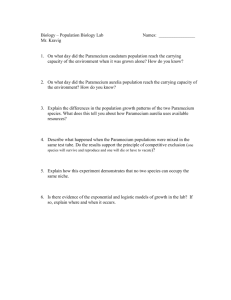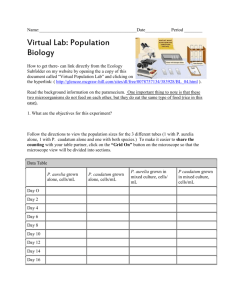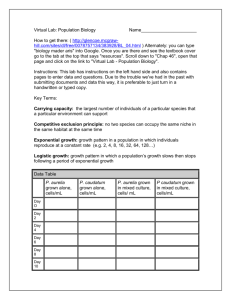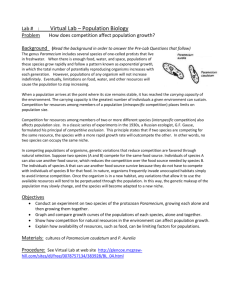Interspecific competition
advertisement
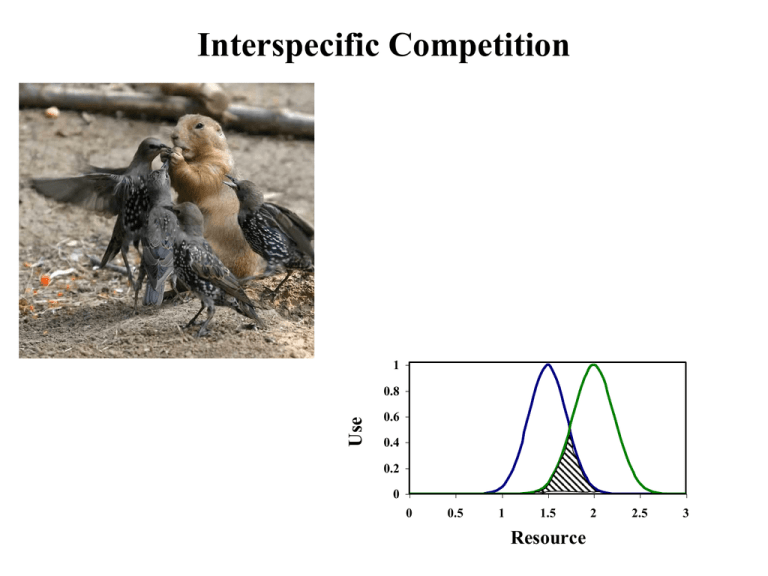
Interspecific Competition 1 Use 0.8 0.6 0.4 0.2 0 0 0.5 1 1.5 Resource 2 2.5 3 The niche and interspecific competition Species A 1 Use 0.8 Species B 0.6 0.4 0.2 0 0 0.5 1 1.5 2 2.5 3 1 Use 0.8 0.6 0.4 0.2 Competition 0 0 0.5 1 1.5 2 2.5 3 Resource When niches overlap, competition results Interspecific Competition Interspecific competition – Individuals of one species suffer a reduction in fecundity, survivorship, or growth as a result of resource exploitation or interference by individuals of another species. Two types of competition: 1. Exploitation – Individuals of one species inhibit individuals of another species INDIRECTLY through the consumption of a shared resource. 2. Interference – Individuals of one species inhibit individuals of another species DIRECTLY by preventing their consumption of a shared resource. Exploitation competition: Paramecia Paramecium bursaria Paramecium aurelia Oatmeal Yeast Paramecium caudatum G.F. Gause (1934, 1935) Exploitation competition • Gause began by growing each species in isolation Paramecium aurelia Paramecium caudatum G.F. Gause (1934, 1935) Paramecium bursaria Exploitation competition • In isolation, each species grew logistically Paramecium aurelia Paramecium caudatum G.F. Gause (1934, 1935) Paramecium bursaria Exploitation competition • Gause then placed pairs of species in the same beaker Paramecium aurelia Paramecium caudatum Paramecium caudatum G.F. Gause (1934, 1935) Paramecium bursaria Exploitation competition • Gause found that the species had very different growth curves when grown together Paramecium aurelia Paramecium caudatum Paramecium caudatum G.F. Gause (1934, 1935) Paramecium bursaria Exploitation competition Species grown in isolation Species grown in competition Exploitation competition depresses population sizes and can lead to extinction Interference competition: Scottish barnacles Chthamalus stellatus Connell (1961) Balanus balanoides Interference competition: Scottish barnacles - Chthalamus occur higher up in the intertidal zone - However, juvenile Chthalamus do settle in the lower Balanus zone High tide Chthamalus stellatus Low tide Balanus balanoides Interference competition: Scottish barnacles Experiments that monitored the fate of Chthalamus juveniles that moved to the lower intertidal (Connell, 1961) showed that: • Balanus crushed or displaced (through its own growth) the Chthalamus juveniles, reducing their survival • If, however, Balanus individuals were removed from the immediate area, juvenile Chthalamus could survive well in the lower intertidal High tide Chthamalus stellatus Low tide Balanus balanoides The Lotka-Volterra Competition Model Alfred James Lotka (1880 - 1949) Vito Volterra (1860-1940) Independently developed a general model of competition between species Developing the Lotka-Volterra Model The Lotka-Volterra Competition Model Imagine we have two species, each growing logistically Species 1: N1 dN1 r1 N1 1 dt K1 Intraspecific competition Species 2: N2 dN 2 r2 N 2 1 dt K2 We need to incorporate INTERSPECIFIC competition The Lotka-Volterra Competition Model Incorporating interspecific competition Species 1: 11 N1 12 N 2 dN1 r1 N1 1 dt K1 Species 2: 22 N 2 21 N1 dN 2 r2 N 2 1 dt K2 Competition coefficients: ii is the effect of species i on its own growth rate (intraspecific competition) ij is the effect of species j on the growth rate of species i (interspecific competition) The Lotka-Volterra Competition Model Understanding α Interspecific < Intraspecific ij < ii Interspecific > Intraspecific ij > ii i j i j i i i i i j i j i i j Here the effect of Species j on species i is less than the effect of Species i on itself. Species i uses more resource (grey box) per capita than does Species j i j i Here the effect of Species j on species i is greater than the effect of Species i on itself. Species j uses more resource (grey box) per capita than does Species i Applying the Lotka-Volterra model to Gause’s data Remember, Gause found two possible outcomes of competition: Outcome 1: One species goes extinct Outcome 2: Both species coexist Are these outcomes of competition predicted by the model? The Lotka-Volterra model predicts: Three possible equilibria: K Equilibrium #1: Nˆ 1 1 ; Nˆ 2 0 11 K2 Equilibrium #2: Nˆ 1 0; Nˆ 2 2 2 K 12 K 2 Equilibrium #3: Nˆ 1 11 1 , 1 12 21 K 21 K1 Nˆ 2 22 2 1 2112 What do each of these mean biologically? Which correspond to Gause’s experimental findings? Matching model to data Data Model K Nˆ 1 1 ; Nˆ 2 0 11 Or K Nˆ 1 0; Nˆ 2 2 2 2 K 12 K 2 Nˆ 1 11 1 1 12 21 K 21 K1 Nˆ 2 22 2 1 2112 When does each outcome occur? What conditions favor coexistence vs. extinction? When is one species driven to extinction? αj←i Ki Species i αi←i Ki Species j αj←j Kj αi←j Kj Anytime: αi←i Ki > αi←j Kj and αj←j Kj< αj←i Ki This can happen in two ways: 500 450 400 350 300 250 200 150 100 50 0 Species 2 is the superior competitor Species 1 Population size Population size Species 1 is the superior competitor Species 2 0 20 40 60 80 100 500 450 400 350 300 250 200 150 100 50 0 Species 2 Species 1 0 Time Species 2 goes extinct and Species 1 reaches its carrying capacity 20 40 60 80 100 Time Species 1 goes extinct and Species 2 reaches its carrying capacity When do the species coexist? αj←i Ki Species i αi←i Ki Species j αj←j Kj αi←j Kj Anytime: αi←i Ki > αi←j Kj and αj←j Kj > αj←i Ki When this occurs: Population size intraspecific competition exceeds interspecific competition 500 450 400 350 300 250 200 150 100 50 0 Species 1 Species 2 0 20 40 60 80 100 Time Species 1 and Species 2 coexist with equilibrium densities: K 12 K 2 Nˆ 1 11 1 1 12 21 22 K 2 21 K1 ˆ N2 1 2112 What favors coexistence? Ecologically similar species Ecologically dissimilar species αj←i Ki Species i αi←i Ki αj←i Ki Species i Species j αj←j Kj αi←j Kj Coexistence unlikely αi←i Ki Species j αj←j Kj αi←j Kj Coexistence likely The more similar two species are ecologically, the more they impact one another and the less likely is coexistence The competitive exclusion principle If two competing species coexist in a stable environment, then they do so as a result of niche differentiation. If, however, there is no such differentiation, then one competing species will eliminate or exclude the other. – Begon et. al. 1996 The competitive exclusion principle 1 Use 0.8 0.6 Competitive exclusion occurs 0.4 0.2 0 0 0.5 1 1.5 2 2.5 3 1 Use 0.8 0.6 Competitive coexistence occurs 0.4 0.2 0 0 0.5 1 1.5 Resource 2 2.5 3 Evidence for the importance of competition 1. Character displacement – Increased ecological differences between species in regions where they occur together 2. Ecological release – The expansion of a species niche under conditions where the other species is absent Character displacement 1 • This often takes the form of character displacement, where the two competing species diverge in a trait that reduces the strength of interspecific competition 0.6 0.4 0.2 0 0 0.5 1 1.5 2 2.5 3 0 0.5 1 1.5 2 2.5 3 1 0.8 Use • When two species occur in sympatry natural selection should favor the evolution of mechanisms that reduce competition Use 0.8 0.6 0.4 0.2 0 Resource Character displacement in Mimulus Character displacement in Mimulus bicolor The frequency of the white/divergent morph is greater when M. bicolor occurs in sympatry with M. guttatus Character displacement in Mimulus bicolor Suggests that competition for pollinators drives character displacement Ecological release Realized Niche of Species 1 Realized Niche of Species 2 Species 2 removed Realized Niche of Species 1 Ecological release: Interactions between wolves and coyotes Canis lupus ≈ 95lbs Canis latrins ≈ 35lbs Ecological release: Interactions between wolves and coyotes • Suggests wolves competitively exclude coyotes • Absence of wolves results in ecological release Practice problem Site Wolves Present Coyotes/km2 Lamar River 0 0.499 Lamar River 0 0.636 Lamar River 0 0.694 Lamar River 0 0.726 Antelope Flats 0 0.345 Antelope Flats 0 0.479 Antelope Flats 0 0.394 Lamar River 1 0.477 Lamar River 1 0.332 Lamar River 1 0.477 Lamar River 1 0.270 Elk Ranch 1 0.279 Elk Ranch 1 0.308 Elk Ranch 1 0.215 Gros Ventre 1 0.312 Gros Ventre 1 0.247 Northern Madison 1 0.194 Does this data support the hypothesis of ecological release in Coyotes? Interspecific competition: summary • Interspecific competition occurs when multiple species overlap in resource use • The ecological outcome of competition can be stable coexistence or competitive exclusion • Competitive exclusion becomes increasingly likely as niche overlap increases • The evolutionary outcome of competition is often ecological character displacement Exam 2 Results Average: 142 points or 89%
